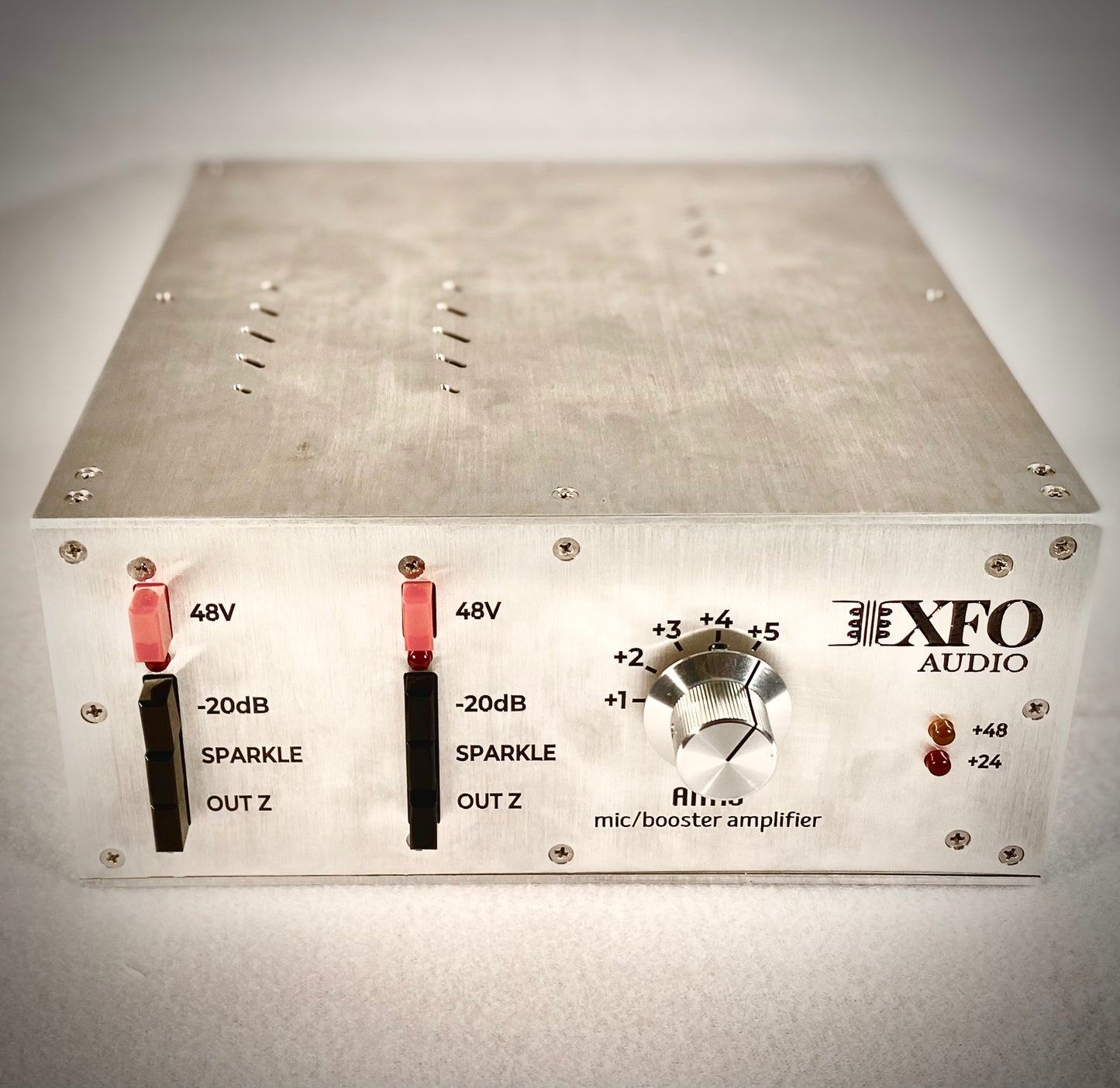XFO Audio
2 channel AM16 mic preamp with 5 way "Sparkle" knob, linear PSU and chassis
2 channel AM16 mic preamp with 5 way "Sparkle" knob, linear PSU and chassis
Couldn't load pickup availability
This listing is for a one-channel XFO Audio HALL AM16 class-A microphone preamplifier.
Handbuilt in the USA, brand new, fully assembled and tested .
Nothing is more important to your sound than how your microphone gets its initial gain before being converted to digital. XFO Audio's HALL AM16 microphone preamplifier has been in development for over two years, and we are proud to officially release to you this exquisite, third-party candidate to the typical API-Neve duality.
Take a step back in time to when the transistor had just been invented and were quickly replacing tubes as a source of gain in audio preamplification. If you ever wondered why old recordings sound so good, the answer is because of discrete, class-A circuits like this. (And the talent, of course.)
John Hall had a productive career designing for many prominent professional audio companies, and the AM16 was a particularly special circuit that deserves more attention. Originally built and sold under the brand name Langevin, (*Langevin is a trademark of Manley Labratories) the AM16 deserves its rightful place in every studio's rack. These units proudly feature original Cinemag transformers. John Hall's unique input and output transformer designs are part of what makes these preamps so special.
__________________________________________________________________________
The primary joys of using an AM16 are as follows:
Simple interface and ease of use
Easy recallability
Large, clear, easy to read faceplate
Tight, forward sounding, Class-A goodness delivered straight to your tape machine or analog to digital converters
Your tracks will enter the box sounding like you want them to sound without a lot of effort. No uphill battle to “fix it in the mix”. Less eq and compression needed. The AM16 is doing all that work for you! Lows are not a struggle, mids and highs are exciting but pleasant.
In sessions with a high track count, AM16 tracks stack very musically.
Transformer balanced circuits emphasize and bring out both the even and odd harmonics which create a rich, musical sound reminiscent of the great recordings of the late 60’s and early 70’s.
You will find that with the AM16, you get more of what you want and less of what you don’t need from your sources. High frequencies will be present, detailed and exciting without being harsh. Low frequencies will be flat and extended without being muddy or overwhelming. And most of all you get an accurate, focused, pleasing midrange that won’t muddy up in the 300-500Hz range, honk in the 1k-1.6k range, or scream in the 2.5k-5k range.
How does it compare to an API?
API is known for its harsher, more distorted sound, which can also present as quite "warm" sounding. This is mostly caused by the all steel output transformer creating "hysterisis". The AM16 is much smoother and richer sounding than an API, while still being "in your face" when necessary.
How does it compare to a Neve?
Due to its class-A design, the AM16 sound is closer to Neve than API, but it still has its own brand of character and class.
_________________________________________________________________________
The four front panel buttons and their use
48V Phantom Power
Turn down your speakers and headphones or they will pop when you turn on Phantom Power to your condenser microphone.
Use phantom power for condenser microphones and for active ribbon microphones.
-20dB Mic Input Pad
This internal network of resistors forms a U-pad, which pads the signal feeding the preamp down by 20dB. This should only be used if you are micing a very loud signal very close. Otherwise you can introduce unnecessary noise to the recording by bringing up a padded signal.
Sparkle
This switch/knob combination is the heart, soul, guts and glory of the AM16. These vintage-design, “matched impedance” preamps expect its line level output to be connected to a 600 ohm load as per the old telephony standard, and it will have a flat frequency response when you do. However, if you plug the output into modern gear with a high input impedance, you will get more gain overall, as well as a big +4dB boost at 20kHz. This is in a very musical “air” band of high frequencies, so even though it is aggressive, it is not harsh. Keeping the load switch out is perfect for dark mics and sources like ribbon mics and cellos. It's also excellent when you want a pleasing, high-frequency emphasis on overhead/cymbals and lead vocals.
OUT Z ratio
This button lowers the output transformer winding ratio from 1:2 down to 1:1. Think of this as an output-side pad. Press this button in for lower output when you like the gain and tone you are getting into the preamp, but you want to hit your converters a little less hard.
_________________________________________________________________________
That’s it! Not much too it. No gain knob, and no output level fader, but lots of ways to gain stage and achieve different results. Choose your mics and placement accordingly. Saturate the input transformer at will, just don’t clip your analog to digital converters! You can always add 10dB of gain if you need it by following the AM16 with a compressor and using make-up gain. Or gain up the line level input on your converter or console where your AM16 is patched in. You will find the AM16 pairs beautifully with some mics, but not others, so be sure to experiment a lot!
I welcome your feedback and input about this and other XFO Audio products. Custom order inquiries also welcome.
XFO Audio
Graham Nystrom (owner)
Share

